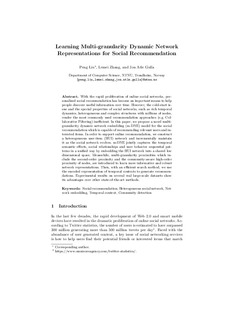| dc.contributor.author | Liu, Peng | |
| dc.contributor.author | Zhang, Lemei | |
| dc.contributor.author | Gulla, Jon Atle | |
| dc.date.accessioned | 2020-01-15T08:56:56Z | |
| dc.date.available | 2020-01-15T08:56:56Z | |
| dc.date.created | 2019-05-05T12:27:27Z | |
| dc.date.issued | 2019 | |
| dc.identifier.citation | Lecture Notes in Computer Science (LNCS). 2019, 11052 LNAI 691-708. | nb_NO |
| dc.identifier.issn | 0302-9743 | |
| dc.identifier.uri | http://hdl.handle.net/11250/2636328 | |
| dc.description.abstract | With the rapid proliferation of online social networks, personalized social recommendation has become an important means to help people discover useful information over time. However, the cold-start issue and the special properties of social networks, such as rich temporal dynamics, heterogeneous and complex structures with millions of nodes, render the most commonly used recommendation approaches (e.g. Collaborative Filtering) inefficient. In this paper, we propose a novel multi-granularity dynamic network embedding (m-DNE) model for the social recommendation which is capable of recommending relevant users and interested items. In order to support online recommendation, we construct a heterogeneous user-item (HUI) network and incrementally maintain it as the social network evolves. m-DNE jointly captures the temporal semantic effects, social relationships and user behavior sequential patterns in a unified way by embedding the HUI network into a shared low dimensional space. Meanwhile, multi-granularity proximities which include the second-order proximity and the community-aware high-order proximity of nodes, are introduced to learn more informative and robust network representations. Then, with an efficient search method, we use the encoded representation of temporal contexts to generate recommendations. Experimental results on several real large-scale datasets show its advantages over other state-of-the-art methods. | nb_NO |
| dc.language.iso | eng | nb_NO |
| dc.publisher | Springer Verlag | nb_NO |
| dc.title | Learning multi-granularity dynamic network representations for social recommendation | nb_NO |
| dc.type | Journal article | nb_NO |
| dc.type | Peer reviewed | nb_NO |
| dc.description.version | acceptedVersion | nb_NO |
| dc.source.pagenumber | 691-708 | nb_NO |
| dc.source.volume | 11052 LNAI | nb_NO |
| dc.source.journal | Lecture Notes in Computer Science (LNCS) | nb_NO |
| dc.identifier.doi | 10.1007/978-3-030-10928-8_41 | |
| dc.identifier.cristin | 1695633 | |
| dc.description.localcode | This is a post-peer-review, pre-copyedit version of an article. Locked until 23.1.2020 due to copyright restrictions. The final authenticated version is available online at: https://doi.org/10.1007/978-3-030-10928-8_41 | nb_NO |
| cristin.unitcode | 194,63,10,0 | |
| cristin.unitname | Institutt for datateknologi og informatikk | |
| cristin.ispublished | true | |
| cristin.fulltext | postprint | |
| cristin.qualitycode | 1 | |
